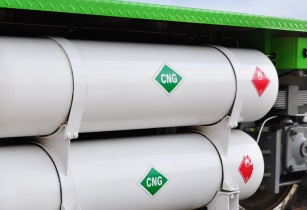The CNG tanks cylinders market reached US$1.7bn in 2022
Demand for CNG tanks cylinders is estimated to surpass US$1.8bn in 2023. During the forecast period, sales are poised to exhibit a 6.7% CAGR. Revenue is anticipated to cross around US$3.5bn by 2033.
Key market highlights
The carbon fiber segment is likely to spearhead the material segment of the market. This segment is expected to expand at 6.6% CAGR during 2023 to 2033.
Growing concerns about environmental impact and emissions have led to an increased interest in CNG as a clean alternative to traditional fuels. This, in turn, is driving the demand for CNG cylinders.
CNG is becoming more popular as countries and companies move toward clean sources of energy to minimise carbon emissions. It will help reduce greenhouse gas emissions compared to traditional fossil fuels.
High availability makes natural gas vehicles (NGVs) an excellent option for high-mileage, centrally fuelled fleets. NGVs might have applications that are confined to those areas with similar fuel range support. CNG is being utilised as a fuel for automobiles more often, particularly in fleets of public transit and commercial vehicles. This drives the demand for CNG tanks and cylinders for storing and transporting the fuel.
The expansion of CNG refueling infrastructure is crucial to support the adoption of CNG as a fuel. As a result, more CNG tanks and cylinders need to be produced and installed. CNG might be utilised to store energy, particularly when there is extra renewable energy that has to be kept for later use. This application calls for more CNG storage space. Clean energy sources such as CNG can also find applications in industries that require heat or power generation. This diversifies the demand for CNG tanks and cylinders beyond just transportation.
Strict environmental regulations on emissions can encourage companies to switch to clean fuels such as CNG. This drives demand for the necessary storage and transport infrastructure.
CNG can be a solution for reducing energy waste in situations where excess renewable energy is generated but cannot be immediately used. Storing this energy in the form of CNG can mitigate waste and bolster demand for storage solutions. As the global energy landscape evolves towards sustainability, CNG can play a role in reducing reliance on traditional fossil fuels. It will help in creating a sustained demand for CNG tanks cylinders.
There has been a recent increase in the popularity of compressed natural gas (CNG) as a vehicle fuel, particularly in commercial fleets and public transit. This is likely to increase the demand for CNG tanks cylinders for storing the gas for usage in cars and buses. The growth of CNG as a transportation fuel necessitates the development of refueling infrastructure. This infrastructure expansion would require a greater number of CNG tanks and cylinders.
CNG is seen as a way to reduce carbon emissions in transportation. This will stimulate demand for CNG tanks and cylinders to support the growing fleet of vehicles running on CNG. Governments offer incentives and subsidies to encourage the adoption of clean fuels. These policies can increase the demand for CNG-powered vehicles and, subsequently, for CNG tanks and cylinders.
Apart from transportation, CNG is used in different industrial processes and power generation. The demand for CNG tanks and cylinders in industrial applications is likely to rise as businesses seek clean energy solutions. The diversification of energy sources for transportation and industrial sectors through CNG can enhance energy security. Thereby driving the demand for CNG tanks and cylinders.
The growth of the CNG market might lead to innovations in tank and cylinder design, material, and manufacturing processes, further contributing to market demand. Geopolitical considerations can influence energy transitions. Countries with ample natural gas resources might encourage CNG adoption, boosting the demand for associated tanks and cylinders. As the energy transition spreads to more regions globally, the demand for CNG tanks and cylinders could see increased adoption in previously untapped markets.
Strict emissions regulations and incentives to promote the use of alternative fuels are encouraging the adoption of CNG vehicles, thereby boosting the CNG cylinder market. CNG is gaining traction in commercial fleets and public transportation due to its cost-effectiveness and lower emissions, driving the need for more CNG cylinders.




